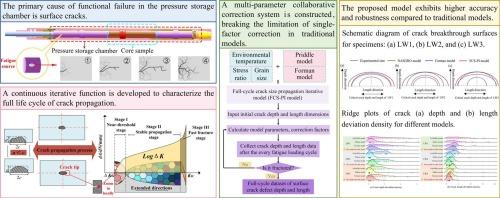Deep in-situ core-preserved coring: A novel full-cycle crack propagation model of the pressure storage chamber
IF 6.8
2区 材料科学
Q1 ENGINEERING, MECHANICAL
引用次数: 0
Abstract
The pressure storage chamber (PSC) for deep in-situ core-preserved coring (ICP-Coring) serves as the key component for in-situ coring and preserving of deep core samples. Subject to long-term in-situ high-temperature and high-pressure loads during service, the chamber surface is prone to fatigue crack initiation and progressive propagation, which may eventually lead to structural failure. To ensure its operational safety, gaining a deep insight into the full-cycle evolution process of surface crack propagation in the PSC is critical. Since existing formulations cannot adequately analyze multi-factor coupling effects, this study develops a full-cycle crack size propagation iterative model (FCS-PI model) for PSC surface cracks to address this limitation. This model incorporates a correction mechanism accounting for the coupled effects of stress states, material microstructures, and environmental factors, enabling the quantitative characterization of the full life cycle of crack propagation in PSC. The universality and accuracy of the proposed iterative model are validated by comparing crack propagation theory calculations with practical engineering cases. The FCS-PI model accurately predicts the fatigue crack growth rate (FCGR), yielding a sum of squared error (SSE) of 6.05 × 10-6 and an average deviation of only 1 % in predicting the critical cycle number (Nc). Furthermore, it demonstrates the smallest crack size deviations—2.2 mm in depth and 6.9 mm in length—outperforming the NASGRO, Forman, and Walker models. The model developed in this study effectively characterizes the full-cycle crack propagation of PSC, providing a more accurate approach for the safety assessment of surface crack-induced failure under high-temperature and high-pressure loading.

深部原位保心取心:一种新的储压室全周期裂纹扩展模型
深部原位保芯压储室(PSC)是深部原位取芯和岩心样品保存的关键部件。在使用过程中,由于长期的原位高温高压载荷作用,腔室表面容易产生疲劳裂纹并逐渐扩展,最终可能导致结构失效。为了确保其运行安全,深入了解PSC中表面裂纹扩展的全周期演化过程至关重要。由于现有公式不能充分分析多因素耦合效应,本研究针对这一局限性,建立了PSC表面裂纹的全周期裂纹尺寸扩展迭代模型(FCS-PI模型)。该模型结合了考虑应力状态、材料微观结构和环境因素耦合影响的修正机制,能够定量表征PSC中裂纹扩展的全生命周期。通过将裂纹扩展理论计算与工程实例进行比较,验证了该迭代模型的通用性和准确性。FCS-PI模型准确预测疲劳裂纹扩展速率(FCGR),预测临界循环数(Nc)的平方误差和(SSE)为6.05 × 10-6,平均偏差仅为1%。此外,该模型的裂缝尺寸偏差最小,深度为2.2 mm,长度为6.9 mm,优于NASGRO、Forman和Walker模型。本研究建立的模型有效表征了PSC的全周期裂纹扩展过程,为高温高压载荷下表面裂纹破坏的安全性评估提供了更为准确的方法。
本文章由计算机程序翻译,如有差异,请以英文原文为准。
求助全文
约1分钟内获得全文
求助全文
来源期刊

International Journal of Fatigue
工程技术-材料科学:综合
CiteScore
10.70
自引率
21.70%
发文量
619
审稿时长
58 days
期刊介绍:
Typical subjects discussed in International Journal of Fatigue address:
Novel fatigue testing and characterization methods (new kinds of fatigue tests, critical evaluation of existing methods, in situ measurement of fatigue degradation, non-contact field measurements)
Multiaxial fatigue and complex loading effects of materials and structures, exploring state-of-the-art concepts in degradation under cyclic loading
Fatigue in the very high cycle regime, including failure mode transitions from surface to subsurface, effects of surface treatment, processing, and loading conditions
Modeling (including degradation processes and related driving forces, multiscale/multi-resolution methods, computational hierarchical and concurrent methods for coupled component and material responses, novel methods for notch root analysis, fracture mechanics, damage mechanics, crack growth kinetics, life prediction and durability, and prediction of stochastic fatigue behavior reflecting microstructure and service conditions)
Models for early stages of fatigue crack formation and growth that explicitly consider microstructure and relevant materials science aspects
Understanding the influence or manufacturing and processing route on fatigue degradation, and embedding this understanding in more predictive schemes for mitigation and design against fatigue
Prognosis and damage state awareness (including sensors, monitoring, methodology, interactive control, accelerated methods, data interpretation)
Applications of technologies associated with fatigue and their implications for structural integrity and reliability. This includes issues related to design, operation and maintenance, i.e., life cycle engineering
Smart materials and structures that can sense and mitigate fatigue degradation
Fatigue of devices and structures at small scales, including effects of process route and surfaces/interfaces.
 求助内容:
求助内容: 应助结果提醒方式:
应助结果提醒方式:


